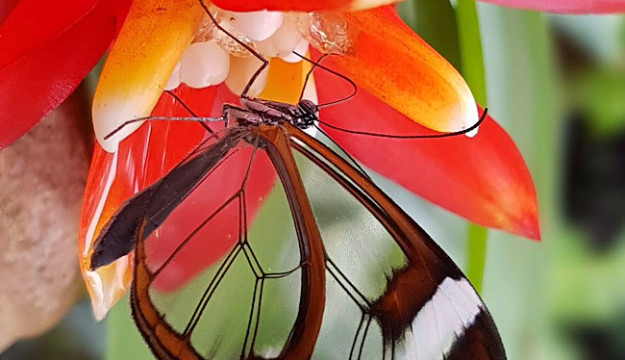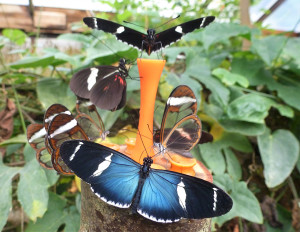
Whilst the country is in national lockdown the team at Stratford Butterfly Farm are busy preparing for when the Farm can once again re-open.
Clive Farrell, owner of the Butterfly Farm, is carefully breeding hundreds of stunning tropical butterflies. Renowned as an international Lepidopterist, Clive is breeding the butterflies in greenhouses on his Ryewater estate in Dorset in readiness for them being released into the Farm’s Flight Area.
At the same time Richard Read, resident Tropical Horticulturist, is overseeing the restructuring and planting of the outdoor gardens from one large wildflower garden to three very distinct planting areas.
Clive, alongside gardener Leslie Patterson, is currently breeding a variety of brightly coloured ‘Heliconius’ or longwing butterflies, the stunningly fragile, semi-transparent ‘Greta oto’ or Glasswing from Costa Rica and the tiny ghost yellow ‘Eurema albula’ from Central and South America. Also being bred is a rare and unusual brown butterfly called ‘Heteropsis fraterna’. Originating from Madagascar, this butterfly is almost certainly the only one being bred in the western world in January!
The butterflies feed on a mix of specially prepared nectar which sustains the butterflies through the lean months when most natural nectar plants are taking a winter rest. The ‘Heliconius’ quickly learn to use the bright orange golf tees which mimic their favourite flower in the rainforest, the Psiguria, and queue up in the mornings for their breakfast feed which is quite a remarkable sight!
Caterpillar foodplants are grown in 270 litre moveable gardens which allows greater flexibility in matching caterpillars and their appetites with appropriate foodplants and giving the plants a respite from their hunger! The greenhouses have underfloor heating and a destratification fan to maintain an even temperature and keep the caterpillars and butterflies warm. Whilst breeding Leslie found that a bundle of dried grass was attracting several Heliconius as a safe roost site. After making up a bouquet of dried Molinia stems, around 70 butterflies return to the grasses every night which is wonderful to watch.
Richard is currently designing three distinct planting areas at the front of the Butterfly Farm. There will be a UK native wildflower garden featuring nectar plants such as lavender, cornflowers and marigolds, perfect for attracting butterflies and bees. There will also be a tropical area, planted with big foliage such as ferns and banana plants, exotic colour from dahlias and pineapple flowers, and structure provided by Phormium, evergreen perennials with striking, sword-like leaves and unusual looking flowers. The third area will be the Prairie bed containing grasses such as Miscanthus and hardy perennials such as Echinacea which provides insects with nectar, pollen, and shelter.
Jane Kendrick, Marketing Manager at Stratford Butterfly Farm said, “When the country emerges from lockdown, we want hundreds of stunning butterflies to emerge at the same time. Breeding the butterflies now ensures we can re-populate the Farm quickly and by preparing our gardens in spring it will ensure they look stunning in the summer. Connecting with nature is beneficial to our mental health and in these uncertain and challenging times, it’s imperative we look forward to brighter days and ones filled with an abundance of butterflies and flowers!”
For information on creating a butterfly wildflower garden please download the Farm’s leaflet and start planning your own beautiful garden now from:-
https://www.butterflyfarm.co.uk/attraction/our-displays/the-wildflower-garden
And visit:-
https://www.butterflyfarm.co.uk/attraction/our-displays/the-wildflower-garden






